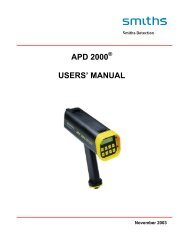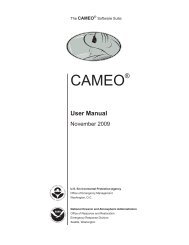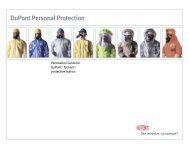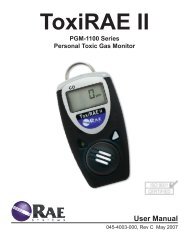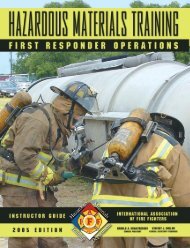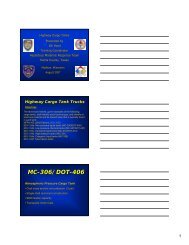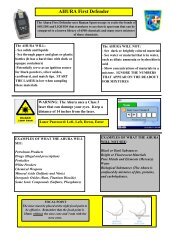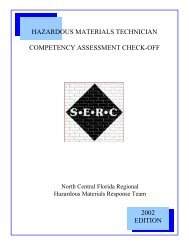Handheld Raman (first defender) - Livonia Professional Firefighters
Handheld Raman (first defender) - Livonia Professional Firefighters
Handheld Raman (first defender) - Livonia Professional Firefighters
You also want an ePaper? Increase the reach of your titles
YUMPU automatically turns print PDFs into web optimized ePapers that Google loves.
and hexamethylene triperoxide diamine (HMTD), are examples of extremely sensitive HMEs as the explosivemolecules incorporate weak bonds between two oxygen atoms which are unstable, and very reactive. Thiscategory of HMEs is incredibly dangerous to produce and handle.Explosives can be characterized as either high or low explosives:■ High explosive materials, such as TNT, RDX, dynamite and ammonium nitrate-fuel oil (ANFO),decompose rapidly in a process called detonation. Once initiated, the instantaneous combustion ispropagated by a detonation wave through the material.■ Low explosive materials require specific conditions, such as confinement, to produce an explosion(deflagration). Low explosives, such as black powder, smokeless powder, and pyrotechnics, decomposevia deflagration as the material undergoes a rapid combustion without the support of a detonation wave.Additionally, high explosives can be further classified into more specific families:■ A primary explosive, such as lead azide or lead styphnate, is a type of high explosive that detonateseasily when exposed to heat, spark, flame, mechanical impact, and so forth. These materials arepackaged into detonators or blasting caps and initiation systems which are used to initiate less sensitive,secondary explosives. A secondary explosive is a second type of high explosive that is less sensitive toinitiation than a primary explosive, but a material that must be initiated with a primary explosive.Because it is less sensitive, the secondary explosive is safer to manipulate and therefore normallycomprises the bulk of the explosive charge in commercial and military applications.Additional components and or types of explosive devices could be any of the following:■ A booster charge, normally consisting of TNT or a combination of TNT and PETN, is a high explosivethat is used to increase the power of the initiating primary explosive in order to ensure reliable initiationof a secondary charge. The type of high explosives which require a booster are referred to as “blastingagents”, for example ANFO, as blasting agents are incapable of detonating without the increased powerof a booster charge. Most booster charges are in cast form, which is when an explosive material has beenheated to a liquid, poured into a mold, and left to re-solidify. Cast booster charges are not to be confusedwith malleable explosive materials; cast boosters have an extremely hard consistency.■ A main charge is the explosive that is detonated by the primary explosive contained within a detonatorand/or booster charge. Normal commercial main charge explosives, either detonator or non-detonatorsensitive, are produced in containers, or packages of varying sizes and/or weights, and can be deliveredin “bulk” form (such as a truck load). Although dynamite is probably the most recognized name incommercial main charge explosives, it is actually the least manufactured due to its cost and use ofnitroglycerin. The most common types of main charge explosives are ANFO, water gels, and emulsions.However, the illicit use of these explosives in the United States accounts for extremely few bombingincidents. The most common bombing incidents incorporate commercial or homemade low explosives.The opposite is true in foreign locations; with high explosives (commercial, military and HME) beingthe type of explosive of choice.■ Plastic explosives, such as C4 and Semtex, are soft, moldable, malleable solid explosives often used fordemolition. These materials are composed of plasticizers, as a binder, and the explosive RDX or acombination of RDX and PETN. Depending on the country of manufacture, RDX may contain minutequantities of HMX. Detonating cord, also known as detcord, is a flexible cord-like material that is filledwith high explosive (normally PETN). Detcord is normally used to initiate high explosive charges in achain, or may even be used as the main charge for very small-scale demolition tasks, such as breachingoperations.Performance of a <strong>Handheld</strong> <strong>Raman</strong> Spectrometer for Explosives Identification May 20093



